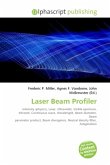Please note that the content of this book primarily consists of articles available from Wikipedia or other free sources online. An excimer laser (sometimes, and more correctly, called an exciplex laser) is a form of ultraviolet laser which is commonly used in eye surgery and semiconductor manufacturing. The term excimer is short for ''excited dimer'', while exciplex is short for ''excited complex''. An excimer laser typically uses a combination of an inert gas (argon, krypton, or xenon) and a reactive gas (fluorine or chlorine). Under the appropriate conditions of electrical stimulation, a pseudo-molecule called an excimer (or in case of noble gas halides, exciplex) is created, which can only exist in an energized state and can give rise to laser light in the ultraviolet range. The UV light from an excimer laser is well absorbed by biological matter and organic compounds. Rather than burning or cutting material, the excimer laser adds enough energy to disrupt the molecular bonds of the surface tissue, which effectively disintegrates into the air in a tightly controlled manner through ablation rather than burning.
Bitte wählen Sie Ihr Anliegen aus.
Rechnungen
Retourenschein anfordern
Bestellstatus
Storno








